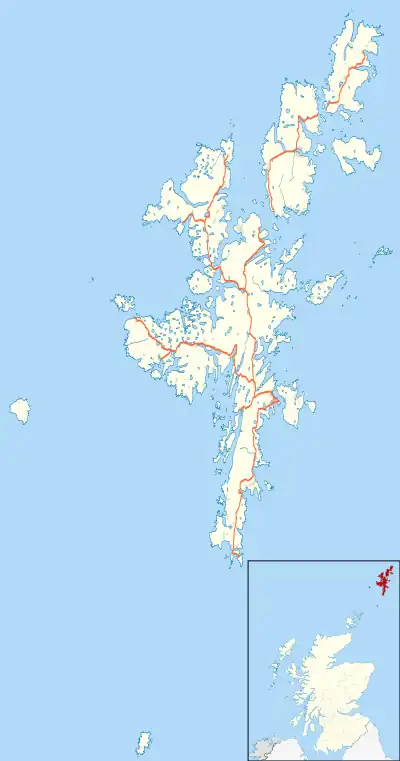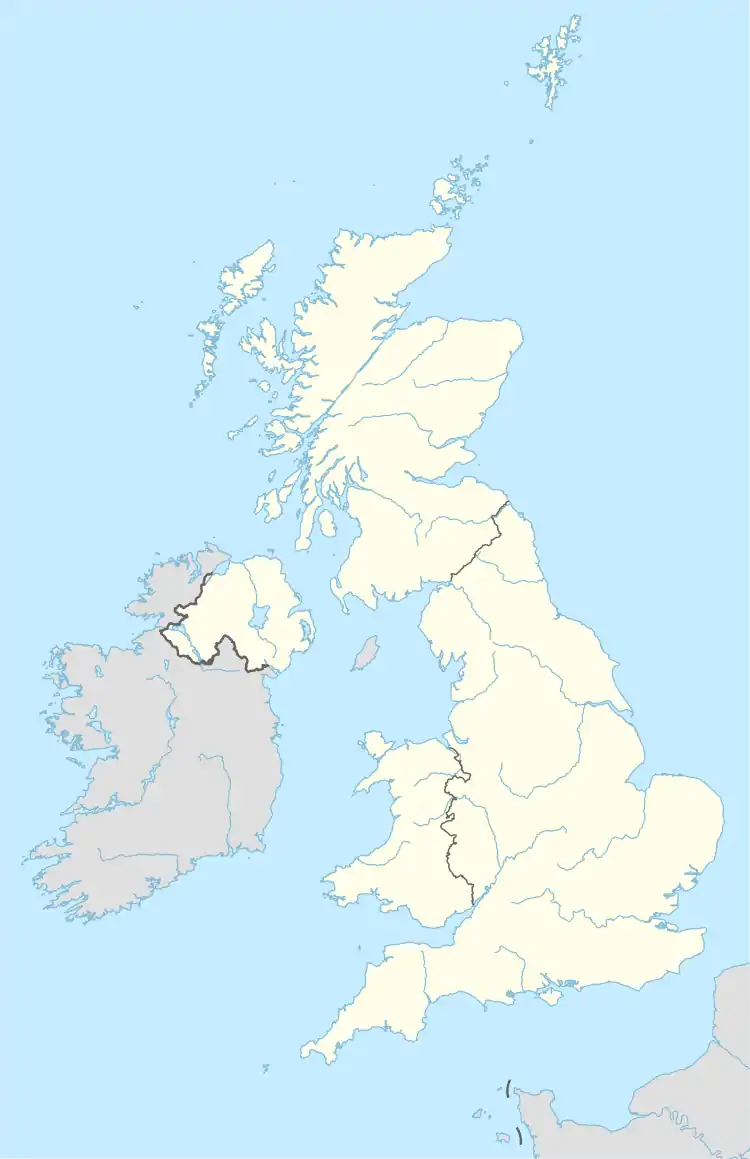| RAF Sullom Voe | |
|---|---|
| Sullom Voe, Shetland Isles in Scotland | |
 RAF Sullom Voe Shown within Shetland  RAF Sullom Voe RAF Sullom Voe (the United Kingdom) | |
| Coordinates | 60°28′00″N 001°16′30″W / 60.46667°N 1.27500°W |
| Type | Satellite Station |
| Site information | |
| Owner | Air Ministry |
| Operator | Royal Air Force |
| Controlled by | RAF Coastal Command |
| Site history | |
| Built | 1938 |
| In use | 1938-1952 |
| Battles/wars | European theatre of World War II |
| Airfield information | |
| Elevation | 1 metre (3 ft 3 in)[1] AMSL |
| Other | Aligned with RAF Scatsta |
Royal Air Force Sullom Voe or more simply RAF Sullom Voe is a former Royal Air Force station near the village of Brae, in the Shetland Isles of Scotland. It was a Flying boat base and was closely associated with the adjacent airfield of RAF Scatsta.[2]
History
Beginnings
The building of this flying boat station started well before the Second World War during 1938 and it became home to various Coastal Command squadrons that patrolled the North Sea, Norwegian Sea and North Atlantic for enemy ships and U-boats. In the early days accommodation was provided by the Clyde-built SS Manella,[3] a ship built in 1921, requisitioned by the Royal Navy in 1939, renamed HMS Manella and sent to Sullom Voe as a supply ship to provide temporary accommodation prior to suitable accommodation being built on-shore at nearby Graven. 201 Squadron was posted there just 25 days before the declaration of war on 3 September 1939. 240 Squadron was posted there a month later on 4 November 1939 then Sullom Voe became the first location in the British Isles to be bombed on Monday 13 November 1939 when four bombs landed in a field. No damage was formally reported apart from the death of a rabbit![4]
The complex was added to when a nearby airfield was built during 1940 and named RAF Scatsta.
Units
| Squadron | Aircraft | Posted from | Posted to | From → To | Notes |
|---|---|---|---|---|---|
| 190 | Consolidated Catalina IB & IV | 17 February 1943 | 1 January 1944 | Formed → Disbanded | Formed from the nucleus of disbanded 210 Squadron and subsequently reformed back to 210 Sqn again.[5] |
| 201 | Saro London I & II Short Sunderland I & II | 9 August 1939 26 May 1940 | 6 November 1939 9 October 1941 | RAF Calshot → RAF Invergordon RAF Invergordon → RAF Lough Erne | Squadron moves twice to Sullom Voe.[6] |
| 204 | Short Sunderland I | 2 April 1940 | 5 April 1941 | RAF Mount Batten → RAF Reykjavik | [7] |
| 210 | Short Sunderland I | 24 November 1939 13 July 1940 | 21 May 1940 4 October 1942 | RAF Invergordon → RAF Pembroke Dock RAF Oban → RAF Pembroke Dock | Detachment from RAF Invergordon then from RAF Oban.[8] |
| 240 | Saro London II | 4 November 1939 27 March 1940 | 12 February 1940 27 May 1940 | RAF Invergordon → RAF Invergordon RAF Invergordon → RAF Pembroke Dock | Squadron moves twice to Sullom Voe.[9] |
| 330 | Short Sunderland II, III and V | 12 July 1943 | 14 June 1945 | RAF Oban → Stavangar Airport, Sola, Norway | Squadron disbanded 21 Nov 1945 and transferred to Norwegian control.[10] |
| 333 | Consolidated Catalina I & IV | 5 May 1943 | June 1945 | RAF Woodhaven → Fornebu (Oslo, Norway) | On detachment before being disbanded 21 November 1945 and transferred to Norwegian control.[10] |
| 413 RCAF | Consolidated Catalina I & IV | 1 October 1941 | 4 March 1942 | RAF Stranraer → En route to Sri Lanka | [11] |
| 461 RAAF | [12] | ||||
| 701 Naval Air Squadron | [12] | ||||
The following units were also here at some point:[12]
During the War
In 1944 one of 210 Sqn's pilots, Flying Officer John Cruickshank, carried out a successful attack off Narvik on a German U-boat, sinking the U-361, which by this time possessed heavy anti-aircraft guns. Despite severe injuries from those guns, he managed to fly his aircraft home and circled until daybreak before he was able to land it safely saving his crew, an achievement for which he was awarded the Victoria Cross.[13]
Post War
After the Second World War: See Sullom Voe, Sullom Voe Terminal and Scatsta Airport.
References
Citations
- ↑ Falconer 2012, p. 184.
- ↑ Falconer 2012, p. 185.
- ↑ "S.S. Manela". Clydesite Scotland. Archived from the original on 1 October 2004. Retrieved 3 November 2013.
{{cite web}}: CS1 maint: unfit URL (link) - ↑ "Sullom Voe". Shetland Museum. Retrieved 3 November 2013.
- ↑ Jefford 1988, p. 69.
- ↑ Jefford 1988, p. 70.
- ↑ Jefford 1988, p. 71.
- ↑ Jefford 1988, p. 72.
- ↑ Jefford 1988, p. 78.
- 1 2 Jefford 1988, p. 89.
- ↑ Jefford 1988, p. 92.
- 1 2 3 "Sullom Voe (Garths Voe)". Airfields of Britain Conservation Trust. Retrieved 15 September 2022.
- ↑ Seymour and Balderson 1999, p. 100.
Bibliography
- Jefford, C.G. (1988). RAF Squadrons. A comprehensive record of the movement and equipment of all RAF squadrons and their antecedents since 1912. Shrewsbury: Airlife. ISBN 1-85310-053-6.
- Falconer, J (2012). RAF Airfields of World War 2. UK: Ian Allan Publishing. ISBN 978-1-85780-349-5.
- Seymour, Mike and Bill Balderson. To The Ends of the Earth: 210 Squadron's Catalina Years, 1941–1945. Pembroke Dock, Pembrokeshire, UK: Paterchurch Publications, 1999. ISBN 1-870745-08-6.